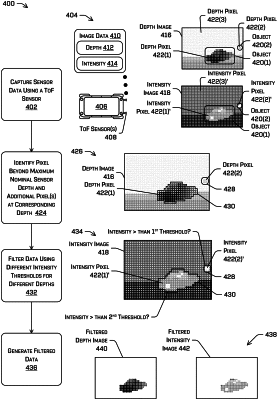| CPC G01S 17/931 (2020.01) [G01S 13/931 (2013.01); G01S 15/931 (2013.01); G06T 7/521 (2017.01); G06T 7/55 (2017.01); G06T 7/70 (2017.01); B60W 60/001 (2020.02); B60W 2554/402 (2020.02); B60W 2554/4041 (2020.02); G06T 2207/10028 (2013.01); G06T 2207/30241 (2013.01); G06T 2207/30252 (2013.01)] | 20 Claims |

|
1. A vehicle comprising:
a time-of-flight sensor;
one or more processors; and
memory storing processor-executable instructions that, when executed by the one or more processors, configure the vehicle to:
configure the time-of-flight sensor in a first configuration;
receive, with the time-of-flight sensor in the first configuration, first depth information generated by the time-of-flight sensor, the first depth information being based, at least in part, on a first modulation frequency;
determine, based on the first depth information, an estimated depth of an object from the time-of-flight sensor, the estimated depth not exceeding a first nominal maximum sensor depth associated with the first modulation frequency;
configure the time-of-flight sensor in a second configuration;
receive, with the time-of-flight sensor in the second configuration, second depth information generated by the time-of-flight sensor, the second depth information being based, at least in part, on a second modulation frequency higher than the first modulation frequency;
determine a plurality of candidate depth measurements based, at least in part, on the second depth information, a first candidate depth of the candidate depth measurements comprising a nominal depth not exceeding a second nominal maximum sensor depth associated with the second modulation frequency and a second candidate depth of the candidate depth measurements comprising a sum of the nominal depth and a multiple of the second nominal maximum sensor depth; and
determine a measured distance of the object from the time-of-flight sensor as one of the plurality of candidate depth measurements closest to the estimated depth.
|